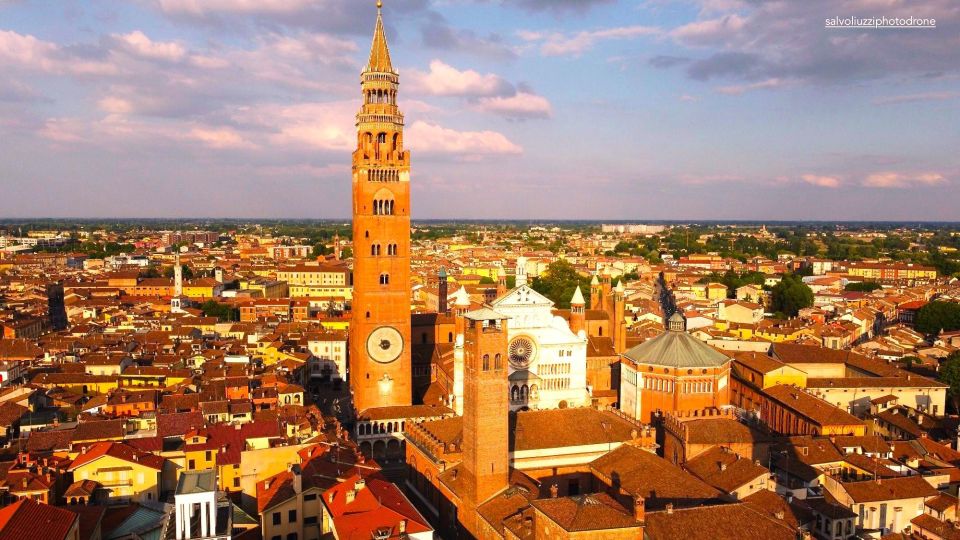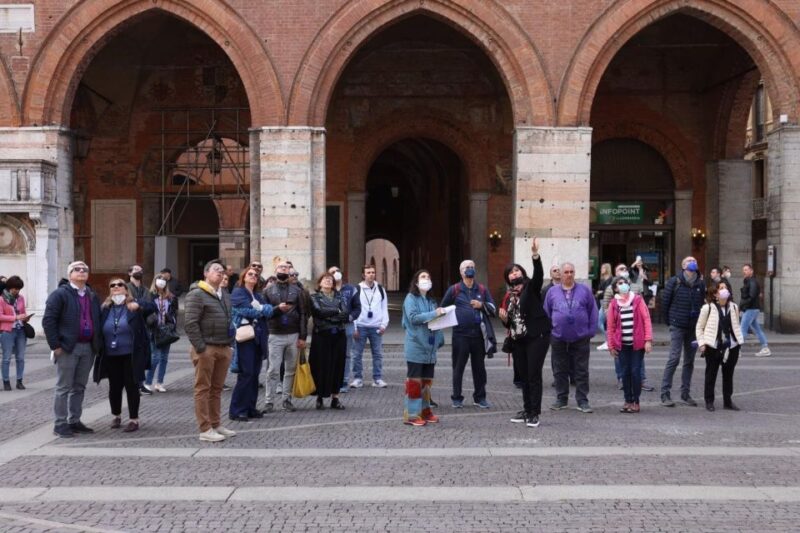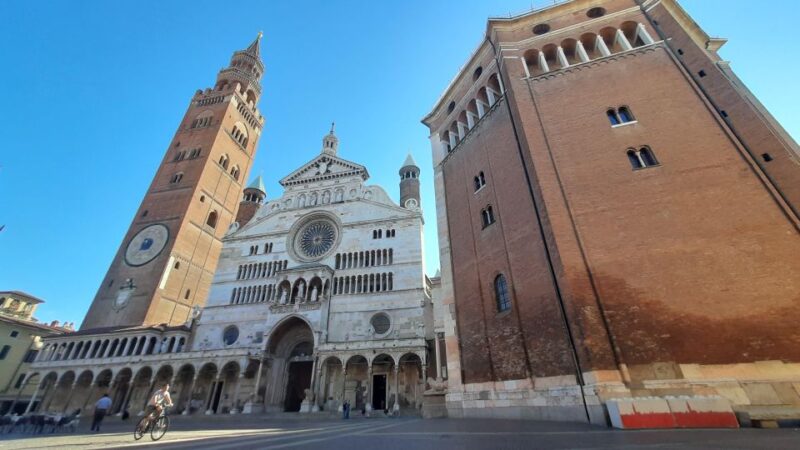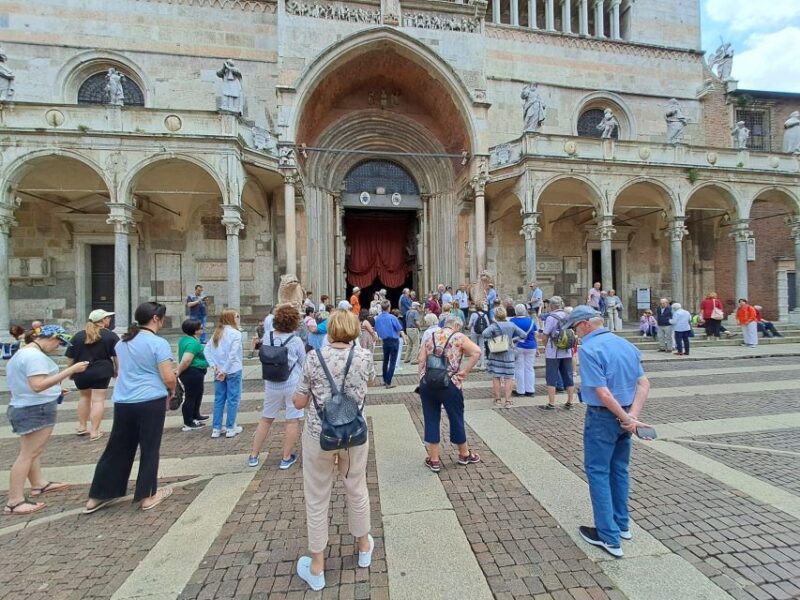Cremona stands out as a remarkable Italian city known for its deep-rooted connection to art and music. With a legacy of legendary violin makers like Stradivari and Guarneri, the city offers a glimpse into the exquisite craftsmanship that has shaped its identity. Beyond the art of lutherie, Cremona boasts stunning architectural landmarks, such as the majestic Cremona Cathedral and the iconic Torrazzo. As one explores its vibrant music scene and annual festivals, they begin to uncover the layers of culture that define this enchanting city. What hidden treasures await those willing to venture further?
Key Points

- Cremona is renowned for its rich lutherie tradition, home to legendary violin makers like Stradivari and Guarneri.
- The city’s architecture features historical gems like the Cremona Cathedral and the towering Torrazzo bell tower.
- Cremona hosts vibrant music festivals, celebrating both local and international talent throughout the year.
- The community fosters music education through schools and workshops, enriching its cultural fabric.
- Local cuisine, including delicacies like Torrone and Casoncelli, reflects the region’s agricultural heritage and creativity.
Historical Significance of Cremona

Cremona, renowned for its rich history and cultural heritage, has long been a pivotal center for art and music in Italy, particularly celebrated for its exceptional craftsmanship in string instrument making.
Founded in the Roman era, the city flourished during the Middle Ages, becoming a hub for luthiers. Cremona‘s legacy includes renowned violin makers like Stradivari and Guarneri, whose instruments are still revered today.
The city’s historical significance extends beyond music; its architectural treasures reflect centuries of artistry and innovation. As a UNESCO-recognized center of lutherie, Cremona showcases a unique blend of tradition and excellence, making it an essential destination for those seeking to understand the deep-rooted connection between culture and craftsmanship in this enchanting Italian city.
You can also read our reviews of more city tours in Cremona
Architectural Marvels to Explore

With its rich history in lutherie and vibrant cultural scene, visitors to this enchanting city will find themselves captivated by its stunning architectural marvels, each telling a unique story of artistry and innovation.
The Cremona Cathedral, often dubbed the Sistine Chapel of the Po Valley, features breathtaking frescoes and intricate details that leave a lasting impression. Nearby, the octagonal Baptistery boasts exquisite Romanesque architecture, while the Torrazzo, Europe’s tallest brick bell tower, offers panoramic views of the city.
The Town Hall and Loggia dei Militi further enhance the historic charm, showcasing the city’s medieval heritage. Exploring these structures allows visitors to appreciate Cremona’s dedication to preserving its architectural grandeur and cultural identity.
The Vibrant Music Scene

Nestled in the heart of Italy, this city pulses with a vibrant music scene that celebrates its rich heritage in lutherie and classical music. Cremona hosts numerous events and festivals that attract musicians and enthusiasts from around the globe. The lively atmosphere brings together locals and visitors alike, creating a unique cultural experience.
Annual Music Festivals: These showcase local and international talent, emphasizing both classical and contemporary genres.
Concert Halls and Theatres: Venues like the Teatro Ponchielli offer a platform for orchestras and soloists, enhancing the city’s artistic reputation.
Community Engagement: Music schools and workshops foster a love for music among the younger generation, ensuring the tradition continues.
Cremona’s music scene is as dynamic as it’s inspiring.
Cremona’s Renowned Lutherie Tradition
Renowned for its unparalleled craftsmanship, Cremona’s lutherie tradition has produced some of the finest string instruments in history, including the legendary violins of Stradivari and Guarneri. This rich heritage continues to thrive, with artisans employing time-honored techniques passed down through generations. The meticulous process of crafting each instrument involves selecting the right woods, shaping the body, and perfecting the finish.
| Instrument Type | Notable Makers | Key Characteristics |
|---|---|---|
| Violin | Antonio Stradivari | Rich tone, exquisite detail |
| Viola | Giuseppe Guarneri | Powerful sound, unique shape |
| Cello | Giovanni Battista Rogeri | Robust resonance, elegant design |
Cremona’s commitment to quality ensures its status as a pivotal center for string instrument making.
More Great Tours NearbyGuided Walking Tour Experience
The guided walking tour of Cremona offers an immersive journey through the city’s rich history and stunning architecture, revealing hidden gems and fascinating stories along the way.
Participants can expect a well-paced exploration lasting 1.5 hours, starting at the Infopoint Cremona.
Key highlights include:
-
Cremona Cathedral: Known as the Sistine Chapel of the Po Valley.
-
Torrazzo: Europe’s tallest brick bell tower, showcasing incredible views.
-
UNESCO Heritage: Insights into the celebrated Cremonese lutherie tradition.
With a knowledgeable guide leading the way, visitors gain a deeper appreciation of Cremona’s cultural significance.
The tour’s accessibility and flexible booking options make it an inviting choice for everyone.
Must-See Attractions
Cremona’s guided tour brings visitors face-to-face with must-see attractions that showcase the city’s artistic and architectural heritage.
The journey begins at the stunning Cremona Cathedral, often referred to as the Sistine Chapel of the Po Valley, where its intricate interiors captivate all.
Next, guests explore the octagonal Baptistery, a masterpiece of medieval architecture, and the imposing Torrazzo, the tallest brick bell tower in Europe.
The tour also includes a visit to the historic Town Hall and the Loggia dei Militi, each revealing the city’s rich history.
Along the way, participants learn about Cremona’s renowned lutherie tradition, a UNESCO-recognized cultural heritage, making this experience truly unforgettable for art and music lovers alike.
Visitor Information and Tips
Visitors should arrive at the Infopoint Cremona – Ufficio Informazioni to kick off their guided walking tour of this artistic gem. This tour lasts 1.5 hours and showcases stunning sites such as the Cathedral and the Torrazzo.
Here are a few tips to enhance the experience:
-
Book in advance: Secure your spot without upfront payment and enjoy a flexible cancellation policy.
-
Dress comfortably: The tour involves walking, so wear appropriate footwear to navigate the cobblestone streets.
-
Bring a camera: Capture the breathtaking architecture and moments that reflect Cremona’s rich artistic heritage.
With these tips, visitors will be well-prepared to explore the beauty and culture that Cremona has to offer.
Local Cuisine and Delicacies
Exploring local cuisine in Cremona reveals a delightful array of traditional dishes that reflect the region’s rich agricultural heritage and culinary creativity.
One can’t miss the renowned ‘Torrone,’ a nougat made with almonds and honey, often enjoyed during festive seasons.
Plus, ‘Casoncelli,’ stuffed pasta parcels with a savory filling, showcase the local love for fresh ingredients.
Meat lovers will appreciate ‘Salame Cremona,’ a flavorful salami that’s perfect with crusty bread.
The region’s cheeses, particularly ‘Grana Padano,’ add a distinctive touch to any meal.
Each dish tells a story, inviting visitors to savor the flavors of Cremona.
With such a vibrant culinary scene, the city truly offers a feast for the senses.
Frequently Asked Questions

What Is the Best Time to Visit Cremona?
The best time to visit Cremona is during spring or early autumn. The weather’s pleasant, allowing visitors to fully enjoy walking tours, outdoor attractions, and vibrant local events without the crowds of peak summer months.
Are There Any Annual Festivals Celebrated in Cremona?
Cremona hosts several annual festivals, including the Fiera di San Pietro and the Stradivari Festival. These events showcase local traditions, music, and crafts, attracting visitors eager to experience the city’s vibrant culture and heritage.
What Languages Are Spoken by Locals in Cremona?
In Cremona, locals primarily speak Italian, but many also communicate in dialects like Cremonese. Visitors often find that English is spoken in tourist areas, enhancing their experience while exploring this vibrant city.
Is Parking Available Near the Historic Center of Cremona?
Parking near the historic center of Cremona’s limited, but visitors can find several public lots within walking distance. Locals recommend arriving early to secure a spot and enjoy the vibrant atmosphere of the area.
Can I Find Souvenirs Related to Music in Cremona?
Visitors can find a variety of music-related souvenirs in Cremona. Shops offer items like violins, sheet music, and themed trinkets, celebrating the city’s rich musical heritage while providing memorable keepsakes for music enthusiasts.
Recap
Cremona captivates visitors with its rich history, stunning architecture, and vibrant music culture.
Those exploring this enchanting city can enjoy its lutherie legacy, witnessing the craftsmanship that birthed legendary instruments.
With guided tours and must-see attractions, there’s something for all.
Plus, indulging in local delicacies adds to the experience.
Whether you’re a music lover or an art enthusiast, Cremona offers a unique blend of culture that leaves a lasting impression on all who visit.
You can check availability for your dates here:More City Tours in Cremona
More Tour Reviews in Cremona
Not for you? Here's more nearby things to do in Cremona we have reviewed
- Cremona: City of art and music in Italian
- Cremona: The Luthiers Workshop
- Cremona: Cremonese Historic Houses
- 2 Best Tours In Cremona
- 2 Best City Tours In Cremona
- 2 Best Private Tours In Cremona
- Cremona: Visit the Violinmaker School – The Secret of Strad
- Cremona: City of Art and Music
- Cremona: City of Art and Music
